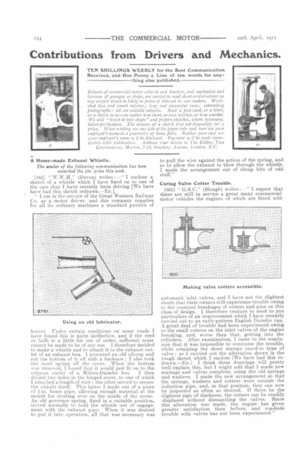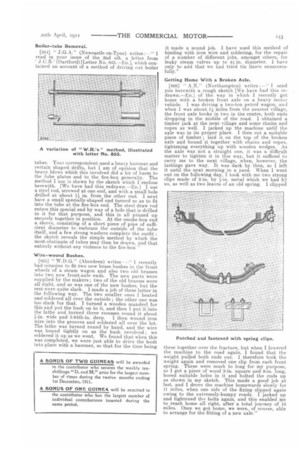Contributions from Drivers and Mechanics.
Page 16

Page 17

If you've noticed an error in this article please click here to report it so we can fix it.
TEN SHILLINGS WEEKLY for the Best Communication Received, and One Penny a Line of ten words for any thing else published.
Drivers of commercial-motor vehic'es and tra:tors, and mechanics and foreinen of garages or shops, are invited to send shirt contributions on any subject which is likely to prove of interest to oar readers. Workshop tips and smart repairs ; long and successful runs ; interesting photographs : all are suitable subjects. Send a post-card, or a letter, or a sketch to us—no matter lintel short, or how written, or how worded. We will ' knock it into shape" and prepare sketches, where necessary, beforepuOlication. The absence of a sketch d ies not disqualify for a 1Vhen writing use one side of Me paper only and men'ion your employer's 'ulnae as a guaranbe of bona fides. Neither your own nor your emphyer's name w It be disclosed. Payment w:11 be made immediatelv after publication. Address your letters to The Editor, THE
Co NI M E R( : A 1. Moro R 7-15, kosebery Avenue, London, E.C.
A Home-made Exhaust Whistle.
The sender of the following communication has been awarded the 10s. prize this week.
LB62] " W.W.H." (Devon) writes :—" I enclose a sketch of a whistle which I have fixed on to one of the cars that I have recently been driving [We have have had this sketch redrawn.—En.].
" I am in the service of the Great Western Railway Co. as a motor driver, and this company supplies for all its ordinary machines a standard pattern of hooter. Under certain conditions on some roads I have found this is quite ineffective, and if the reed or bulb is a little bit out of order, sufficient noise cannot be made to be of any use. I therefore decided to make a whistle and to attach it to the exhaust outlet of an exhaust box. I procured an old oil-cup and cut the bottom of it off with a hacksaw ; I also took the steel spring off the cover. When the bottom was removed, I found that it would just fit on to the
exhaust outlet of a Milnes-Daimler bus. I then drilled two holes in the hinged cover, to one of which I attached a length of wire ; the other served to secure the whistle itself. This latter I made out of a piece cf On. brass pipe, allowing enough material at the mouth for riveting over on the inside of the cover. An old governor spring, fixed in a suitable position, served normally to hold the whistle out of engagement with the exhaust pipe. When it was desired to put it into operation, all that was necessary was
to pull the wire against the action of the spring, and so to allow the exhaust to blow through the whistle. I made the arrangement out of cheap bits of odd stuff."
Curing Valve Cotter Trouble.
[8631 G.S.C." (Slough) writes: -" I expect that there are still in service a great many commercial motor vehicles the engines of which are fitted with automatic inlet valves, and I have not the slightest doubt that their owners still experience trouble owing to the constant breakages of cotters and pins on this class of design. I therefore venture to send to you particulars of an improvement which I have recently carried out to an earlv-pattern English Daimler van. A great deal of trouble had been experienced owing to the small cotters on the inlet valves of the engine breaking, and, worse than that, getting into the cylinders. After examination, I came to the conclusion that it was impossible to overcome the trouble, while retaining the short stumpy cased-in type of valve ; so I carried out the alteration shown in the rough sketch which I enclose [We have had this redrawn.—En.1 I think these drawings will pretty well explain this, but I might add that I made new seatings and valves complete, using the old springs and washers. I made the new arrangement so that the springs, washers and cotters were outside the induction pipe, and, in that position, they can now be inspected as often as desired. If there be the slightest sign of slackness, the cotters can be readily displaced without dismantling the valves. Since this alteration was made, the engine has given greater satisfaction than before, and roadside trouble with valves has not been experienced."
Boiler-tube Removal.
[864] " J.G.A." (Newcastle-on-Tyne) writes :--" I read in your issue of the 2nd ult. a letter from J.C.B.' (Dartford) [Letter No. 843.—ED.], which contained an account of a method of driving out boiler tubes. Your correspondent used a heavy hammer and certain shaped drifts, but I am of opinion that the heavy blows which this involved did a lot of harm to the tube plates and to the fire-box generally. The method I use is shown by the sketch which I enclose herewith. [We have had this redrawn.—ED.] I use a steel rod, screwed at one end, and with a small hole drilled at about 11 in. from the other end. I next have a small specially-shaped end turned so as to fit into the tube at the fire-box end. The steel draw rod enters this special end by way of a hole that is drilled in it for that purpose, and this is all pinned up securely together in position. At the smoke-box end a sleeve, consisting of a short piece of pipe of sufficient diameter to embrace the outside of the tube itself, and a few strong washers complete the outfit ; the sketch reveals the simple method by which the most-obstinate of tubes may then be drawn, and that entirely without any violence to the fire-box " Wire-wound Bushes.
[863} " W.D. G." (Aberdeen) writes --" I recently had occasion to fit two new brass bushes in the front wheels of a steam wagon and also two old brasses into two new front-axle ends. The new parts were supplied by the makers ; two of the old brasses were all right, and so was one of the new bushes. but the rest were quite slack. I made a job of these latter in the following way. The two smaller ones I heated and soldered all over the outside ; the other one was too slack for that. I turned a wooden mandrel for this and put the bush on to it, and then I put it into the lathe and turned three recesses round it about i-in. wide and 3-64th-in. deep. I then wound iron wire into the grooves and soldered all over the lot. The lathe was turned round by hand, and the wire was bound tightly on as the bush revolved ; we soldered it up as we went. We found that when this was completed, we were just able to drive the bush into place with a hammer, so that for the time being it made a sound job. I have used this method of binding with iron wire and soldering, for the repair of a number of different jobs, amongst others, for leaky steam valves up to 441-in. diameter. I have only to add that we had tried tin liners unsuccessfully."
Getting Horne With a Broken Axle.
[886] " A.N." (Northampton) writes :—" I send you herewith a rough sketch [We have had this redrawn.—ED.] of the way in which I recently got home with a broken front axle on a heavy motor vehicle. I was driving a two-ton petrol wagon, and when I was about 1!-1 miles from the nearest village, the front axle broke in two in the centre, both ends dropping in the middle of the road. I obtained a timber jack at the next village and some chains and ropes as well. I jacked up the machine until the axle was in its proper place. I then cut a suitable piece of timber ; laid it on the top of the broken axle and bound it together with chains and ropes, tightening everything up with wooden wedges. As the axle was not a straight one, it was a difficult matter to tighten it in this way, but it sufficed to carry me to the next village, when, however, the lashings gave way. It was dark by then, so I left it until the next .morning in a yard. When I went out on the following day, I took with me two strong clips made of 2-in. by I-in. metal which we had by us, as well as two leaves of an old spring. I clipped these together over the fracture, but when I lowered the machine to the road again, I found that the weight pulled both ends out. I therefore took the weight again and removed one clip from each front spring. These were much to long for my purpose, so I got a piece of wood 3-in, square and 9-in, long, bored suitable holes in it and bolted the ends up as shown in ray sketch. This made a good job at last, and I drove the machine homewards slowly for 11 miles, when one side of the fixing slipped again owing to the extremely-bumpy roads. I jacked up and tightened 111-3 bolts again, and this enabled me to reach home all right, after a total journey of 16 miles. Once we got home, we were, of course, able to arrange for the fitting of a new axle."


















